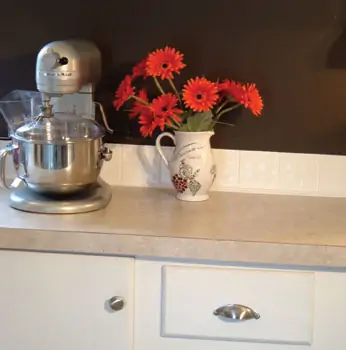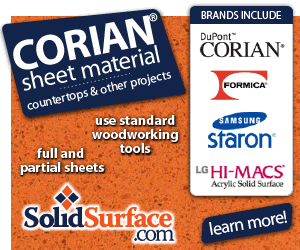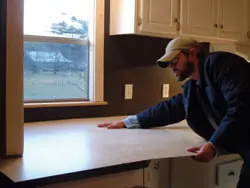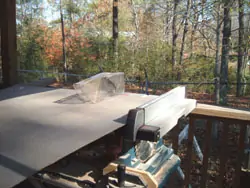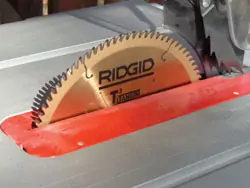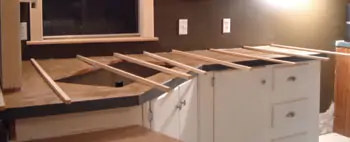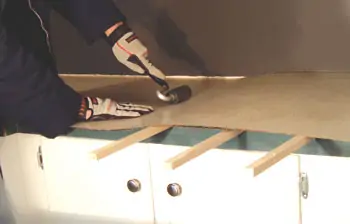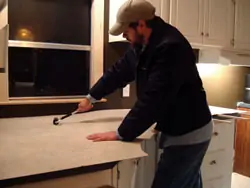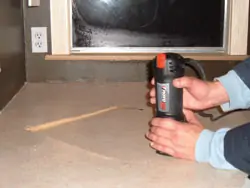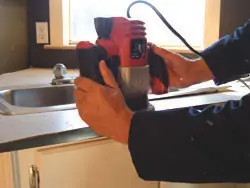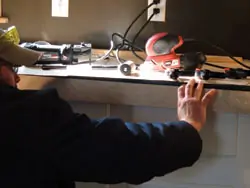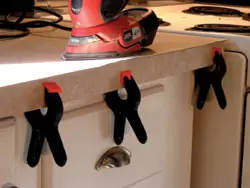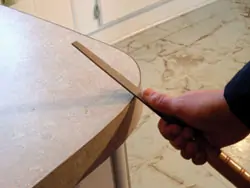Laminate countertops are attractive affordable and you can install the material yourself.
A popular and economical choice for kitchen countertops is plastic laminate, available in many attractive colors and designs. Laminate countertops (often called Formica, although that is actually the name of only one manufacturer) come in just about every color and pattern imaginable. From contemporary patterns to styles that mimic popular stone looks, laminate is durable, affordable, and you can install it yourself.
If installing new sheet laminate over old laminate, material, first thoroughly sand and clean the old surface.
During the course of a recent kitchen remodel, I recovered a laminate countertop with newer, more brightly colored laminate sheeting with a granite-type pattern. This kitchen had three separate countertops, at various heights and locations around the kitchen. So I bought three new 4-by-8-foot sheets of laminate and went to work. Here’s how to do it.
Then remove all obstacles, such as sinks and faucets.
Prepping and Planning
If you’re installing over existing laminate, the old countertop surface should be thoroughly sanded and cleaned to remove all debris and contaminants. The sanding helps to remove any existing glossy coating and roughs up the surface for better bonding with the countertop adhesive. I used a random orbital power sander over all existing countertop surfaces before cleaning.
Test-fit the laminate. In some cases, you can set the sheet in place, and use a marker to trace the shape of the countertop on the underside of the new laminate. allow some extra room outside of your traced lines when rough-cutting the sheet.
Next, measure the dimensions of the countertop and sketch a diagram of the countertop shape that you’re going to have to cut out of the sheet laminate. The edges of these sheets are very straight, so you should plan for the edges to line the rear of the cabinet against the wall, when possible. Take one countertop at a time and sketch its shape. As you sketch your designs, the sheet cutouts should roughly mirror the shape of the final countertop, but add a few extra inches so the sheet edges will overhang the edges of the countertop. You’ll go back later with a router and trim the edges flush with the counter.
Love the look of Corian®, but don’t love the cost? Well DIY solid surface countertops can be an extremely affordable and elegant option with material from SolidSurface.com. Using basic woodworking skills and tools, you too can install your own custom solid surface countertop, desktop, bathroom vanity, laundry prep areas, shower walls, or other surface of your choosing. Click here for more information.
With your plan sketched out, transfer those dimensions to the sheet laminate, marking the appropriate cutlines on the material.
The rip fence of a table saw helps to guide the sheet for an accurate cut.
Cutting the Laminate
You have a couple of options for cutting laminate. There are special blades that allow you to use a utility knife to cut sheet laminate. If using a utility knife, also use a straightedge to guide the knife for a smooth and even cut. You can also cut plastic laminate with a circular saw, jig saw or table saw with a fine-tooth blade. Place a strip of masking tape where the cut is to be made to prevent chipping and make the line easier to see. When using a power circ saw or jigsaw, cut from the back side of the laminate. These blades cut on the upstroke, and cutting from the back will help prevent chipping.
To cut the sheet laminate, I used a fine-tooth blade installed backwards on a table saw. Note: See warning below.
Here’s another tip, and also how I cut the laminate for this project: I used a fine-tooth blade installed backwards in a table saw. Now, let me emphasize that you should NEVER cut anything else with the blade on backwards other than sheet laminate. But I was told of this trick by a professional cabinet maker, and thought I’d give it a shot. And I was pleased to find that this method works like a charm. The rip guide of the table saw helps to control a straight cut, and although the cutting process takes longer with the blade on backwards, the cut was perfect. In fact, the blade simply peels away a strip of the material in a ribbon that’s as wide as the kerf of the blade, and the cuts are perfectly smooth. Granted, you’ll need to set up both outfeed and lateral supports to work with the big 4-by-8 sheets, but I found this to be a great way to make accurate cuts. Once you’re finished rough cutting the sheets to shape, immediately change the blade back around to its normal cutting direction.
Brush on an even coat of contact cement to both the old, prepped countertop surface and to the underside of the new sheet laminate. Allow the adhesive to dry until it is tacky.
Gluing the Laminate
Plastic laminate is generally applied with contact cement. After the old countertop has been prepped (sanded, cleaned, dried), brush contact cement onto the countertop surface. Apply a smooth, even layer covering the entire surface. Then brush a layer of contact cement on the back side of the laminate cutout for the counter. Allow the adhesive to dry until tacky (usually 5 to 10 minutes, but check the contact cement label for recommendations).
Then place dowels or wood strips, spaced roughly 1 foot apart, over the old countertop surface.
At this point, place strips of wood or dowels over the countertop roughly 1 foot apart. Don’t worry—the strips won’t stick. The wood strips will act as a temporary barrier between the sheet and existing countertop. They should be long enough to extend beyond the edge of the counter so you can grab the end and pull them out later. Next, place the new sheet laminate face up on top of the wood strips. Be careful when placing the sheet; don’t let the two glued surfaces touch yet or they will bond together! It’s best to recruit some help when placing the laminate—I did. Even when cut to size, the material is still slightly larger than the countertop surface and difficult to maneuver without some assistance.
The new sheet should be accurately positioned right above its final installed location, “hovering” on the wood strips with its edges flush against the surrounding walls.
Starting in one corner, remove the first wood strip and use a j-roller to roll the sheet down onto the countertop surface.
Applying the Countertop Surface
Starting at one end of the sheet, remove the first wood strip or dowel and use a J-roller to press the new sheet down onto the counter, bonding the two pieces together. Use the roller to apply pressure to the sheet so the glue will have a strong bond and no air pockets. Work toward the opposite end of the counter, removing the wood strips one at a time and rolling the entire surface thoroughly as you progress.
Continue working from one end to the other, removing wood strips and rolling the top to bond the cement as you go.
By the time you reach the end of the counter, the entire new laminate surface should be securely bonded. You can then go back with a router, fitted with a flush trim bit, and trim away the excess laminate overhang flush with the edge of the counter. Do not rush the router; let the tool do the work.
I used a Rotozip with a Tracing Bit to make the sink cutout. You can also use a jigsaw.
I then temporarily replaced the sink to keep the area neat and uncluttered while I finished the counter.
Cutouts
You may encounter obstructions such as sinks, faucets, etc. that you have to work around. For this particular project I had to remove a sink, install the laminate and then make a cutout in the new laminate to replace the sink. You can use a jigsaw with a fine-tooth blade for the cutout, but I used a Rotozip with a Tracing Bit. With a Rotozip you can easily plunge the bit through the laminate surface (no pilot hole needed). Plus, the patented Tracing Bit tip has a non-cutting “bead” at the end of the bit that avoids the object behind the surface (the high-density particleboard counter) and only cuts out the material desired (laminate, in this case). This special bit treats the underlying particleboard as a template, so you can zoom your Rotozip around the sink cutout and quickly cut the laminate to match. One note: the Rotozip is too aggressive for trimming the edges flush, so stick with a router for that chore.
Use a router with a flush trim bit to cut the laminate to match the counter.
Edge Strips
For the most part, edge strips install in much the same way as the surface sheeting. Brush contact cement on the back of the strip and on the surface of the old countertop edge (after prepping). In this case you won’t be using the wood strips. Allow the glue to dry tacky, then install the edge strip, roll it in with the J-roller, and use clamps to hold the strip firmly in place while it dries.
Cut the edge strips to size, and glue them in place with contact cement in the same manner that you glued the countertop surface(but without the wood strips).
Another note on edge strips: Don’t break the edge strip at a curve. In some cases your edge strip may not be long enough to cover the entire countertop edge, and you’ll have to join two edge strips. Ideally you can stop the edge strip at a corner and begin the second strip on the other side. However, what if you don’t have corners? One of the countertops in this project had a sweeping curved edge that rounded three sides of the counter—too long for a single edge strip. When joining two strips, break the strips at a long, flat area of the edging, rather than at a curve. The edge strips have a tendency to straighten out, and you’ll find it difficult or even impossible to get the edging to stay glued in place if you break it at a curve. Curves should happen in the middle of the edge strips.
Instead of using wood strips or dowels for the edge strips, roll the strips down with a j-roller and then clamp them in place until the adhesive sets.
Once the edge strips are securely bonded, just remove the clamps and trim in the edges with a router and flush trim bit. With bits that use a guide wheel, carefully set the guide so the bit cuts only the edge of the laminate but not the adjoining countertop surface. You can then go along the edges with a half-round file to slightly bevel the transition between the countertop surface and the edge strips. You can also use a special laminate filler to doctor up any nicks or other minor damage.
After flush-trimming the strips with a router, slightly bevel the countertop edges with a half-round file.
After doing this to three countertops, the kitchen looked much better. I used a solvent to remove the excess contact cement. I then added a simple tileboard backsplash with a small PVC trim strip at the bottom (for water resistance), and the countertop job was complete.
Seaming Laminate
This project did not require me to seam the laminate because each of the three countertops fit within the footprint of the 4-by-8-foot sheets. This won’t always be the case with an installation. Sometimes the counter will be too large and you have to join two sheets. Here are a few tips on seaming the laminate:
- First bond the larger sheet in place like normal.
- Put a narrow strip of wax paper down along the edge of the larger piece.
- Use wood strips to keep the second piece away from the cemented surface of the counter.
- At the seam, position the second piece tightly flush against the first piece, on top of the wax paper. Tape the second piece to hold it in place.
- Roll the second piece down as usual, removing the woods strips as you progress.
- Once the second piece is securely bonded in place, then lift the edge covering the wax paper. Remove the paper and use your J-roller to roll from the middle of the second piece toward the seam, bonding the seam tightly.


